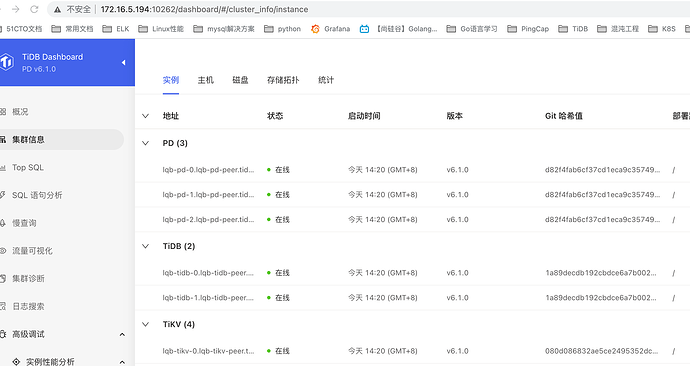Note:
This topic has been translated from a Chinese forum by GPT and might contain errors.Original topic: 【 SOP 系列 41 】TiDB 集群安装 TiDB Dashboard
Thanks to @清风明月 for the contribution.
TiDB Dashboard is a visual panel introduced from TiDB 4.0, used to help observe and diagnose the entire TiDB cluster. For details, see TiDB Documentation - TiDB Dashboard. This article will introduce how to access TiDB Dashboard in a Kubernetes environment. By creating a Dashboard, you can quickly view cluster issues, and it is recommended to enable it.
1. Accessing TiDB Dashboard
Method 1: Access using NodePort Service
1.1 Create a NodePort Service
[root@k8s-master tidb]# cat lqb-nodeport.yaml
apiVersion: v1
kind: Service
metadata:
name: access-dashboard
namespace: tidb ## Replace with the actual namespace
spec:
ports:
- name: dashboard
port: 10262
protocol: TCP
targetPort: 10262
type: NodePort
selector:
app.kubernetes.io/component: discovery
app.kubernetes.io/instance: yz #### Replace with the cluster name
app.kubernetes.io/name: tidb-cluster
1.2 If there are more than one PD, add the following configuration
pd:
baseImage: pingcap/pd
config: |
[dashboard]
internal-proxy = true
replicas: 3
requests:
cpu: "100m"
storage: 12Gi
mountClusterClientSecret: false
storageClassName: "local-storage-monitoring"
Method 2: Access via port forwarding
[root@k8s-master tidb]# kubectl port-forward --address 0.0.0.0 svc/lqb-discovery 10262:10262 -ntidb
Forwarding from 0.0.0.0:10262 -> 10262
Then IP:10262/dashboard
http://172.16.5.194:10262/dashboard
Method 3: Access via ingress proxy
[root@k8s-master tidb]# cat ingress-dashboard.yaml
apiVersion: networking.k8s.io/v1
kind: Ingress
metadata:
name: lqb-yz-dashboard
namespace: tidb
spec:
rules:
- host: "lqb.mytest.org"
http:
paths:
- path: "/dashboard"
pathType: Prefix
backend:
service:
name: lqb-discovery
port:
number: 10262
After deploying Ingress, you can access TiDB Dashboard outside the Kubernetes cluster via http://${host}/dashboard.
2. Enable Continuous Performance Analysis (TidbNGMonitoring CR)
Deploy TidbNGMonitoring CR
[root@k8s-master tidb]# cat tidbngmonitoring-yz.yaml
apiVersion: pingcap.com/v1alpha1
kind: TidbNGMonitoring
metadata:
name: tidbngmonitoring-yz
namespace: tidb
spec:
clusters:
- name: yz
namespace: tidb
configUpdateStrategy: RollingUpdate
ngMonitoring:
requests:
storage: 10Gi
version: v6.1.0
storageClassName: local-storage
Apply the configuration file
[root@k8s-master tidb]# kubectl apply -f tidbngmonitoring-yz.yaml
tidbngmonitoring.pingcap.com/tidbngmonitoring-yz created
Enable Continuous Performance Analysis
-
Enter TiDB Dashboard, select Advanced Debugging > Profiling Instances > Continuous Profiling.
-
Click Open Settings. On the right-side Settings page, turn on the switch under Enable Feature. Set the Retention Period or keep the default value.
-
Click Save.

